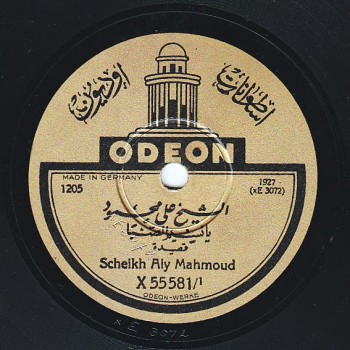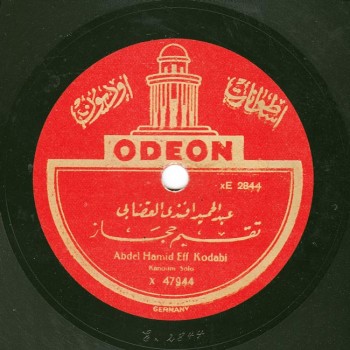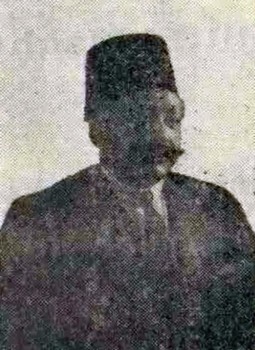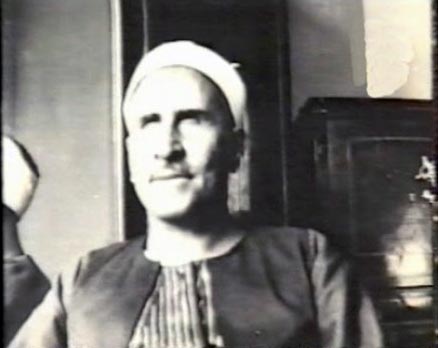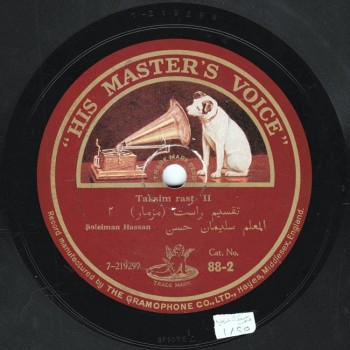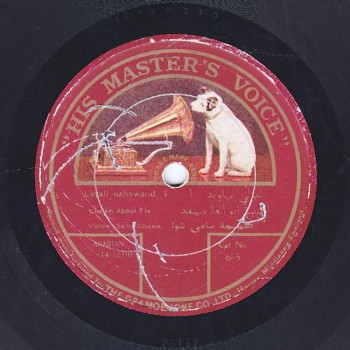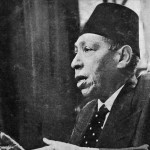The Arab Music Archiving and Research foundation (AMAR), in collaboration with the Sharjah Art Foundation (SAF), presents “Niẓāmunā al-Mūsīqī”.
Dear listeners,
Welcome to a new episode of “Niẓāmunā al-Mūsīqī”.
Today, we will be resuming with Mr Mustafa Said our discussion about taqsīm-s (modal improvisation) and a practical way to master and produce good taqsīm-s.
We have understood the taf‘īla-s or the meters in general, and we have applied them on one string and one note.
Can we now listen to an example of more than one note on one string?
Here are three letters …
(♩)
Good?
Now this …
(♩)
Beautiful!
All this was played on these three letters.
Are these letters in an ascending, descending, or random order?
In order to follow the segmentation/cadence of the rhythm or of the taf‘īla, one can play in this order …
(♩)
Only.
So one would play as follows …
(♩)
Wow!
We have reached three notes. When will we reach four and five? And when will we be playing on two strings?
Whenever you wish.
So it is according to one’s predisposition.
Each case is different.
We have initially selected part of a maqām (musical mode).
Until today, I only work with one string, always trying to come up with something new and to add to the taf‘īla-s.
How does this reflect on the final taqsīm-s after the training? Will one move automatically among all the strings and maqām-s?
Of course, if one has the will. Once a significant repertoire is memorised, and the rhythmic maqām system is learned …
(♩) (Sulaymān Ḥasan – Taqsīm rāst)
One can then come up with ornaments and ideas.
For the thousandth time, it is difficult without someone to guide you.
We are back to the idea of the disciple and the mentor.
“Learning taqsīm without a teacher in two weeks” is nonsense.
What about two years?
A guide is essential …
(♩) (‘Abd al-Ḥamīd al-Quḍḍābī – Taqsīm ḥijāz)
So Mustafa, how did you come up with this idea? Is it your idea or have you learned it somewhere?
Studying under mashāyikh teaches one a lot about language. When one says: “Yā lēl yā ‘ēn”…
(♩) (Abū al-‘Ilā Muḥāmmad – Layālī nahāwand)
Or when one improvises verses to a certain baḥr (poetry meter) …
(♩) (‘Alī Maḥmūd – Yā nasīm al-ṣabā).
This is the best exercise in relation to the segmentation of taf‘īla-s following the notes, applying them to the notes.
Some say that it is taught in Central Asia… I do not know, but they surely did not reinvent the wheel, it is as clear as day.
(♩)
Dear listeners,
We have reached the end of today’s episode of “Niẓāmunā al-Mūsīqī” presented to you by Fadil al-Turki and Mr Mustafa Said.
We will meet again soon.
“Niẓāmunā al-Mūsīqī” is brought to you by Mustafa Said.
- 221 – Zakariyya Ahmed – 12 (1/9/2022)
- 220 – Zakariyya Ahmed – 11 (1/9/2022)
- 219 – Zakariyya Ahmed – 10 (11/25/2021)
- 218 – Zakariyya Ahmed – 9 (10/26/2021)
- 217 – Zakariyya Ahmed – 8 (9/24/2021)
- 216 – Zakariyya Ahmed – 7 (9/4/2021)
- 215 – Zakariyya Ahmed – 6 (8/28/2021)
- 214 – Zakariyya Ahmed – 5 (8/6/2021)
- 213 – Zakariyya Ahmed – 4 (6/26/2021)
- 212 – Zakariyya Ahmed – 3 (5/27/2021)
- 211 – Zakariyya Ahmed – 2 (5/1/2021)
- 210 – Zakariyya Ahmed – 1 (4/28/2021)
- 209 – W-al-Lāhi lā astaṭī‘u ṣaddak 2 (4/6/2017)
- 208 – W-al-Lāhi lā astaṭī‘u ṣaddak 1 (3/30/2017)
- 207 – Bashraf qarah baṭāq 7 (3/23/2017)

